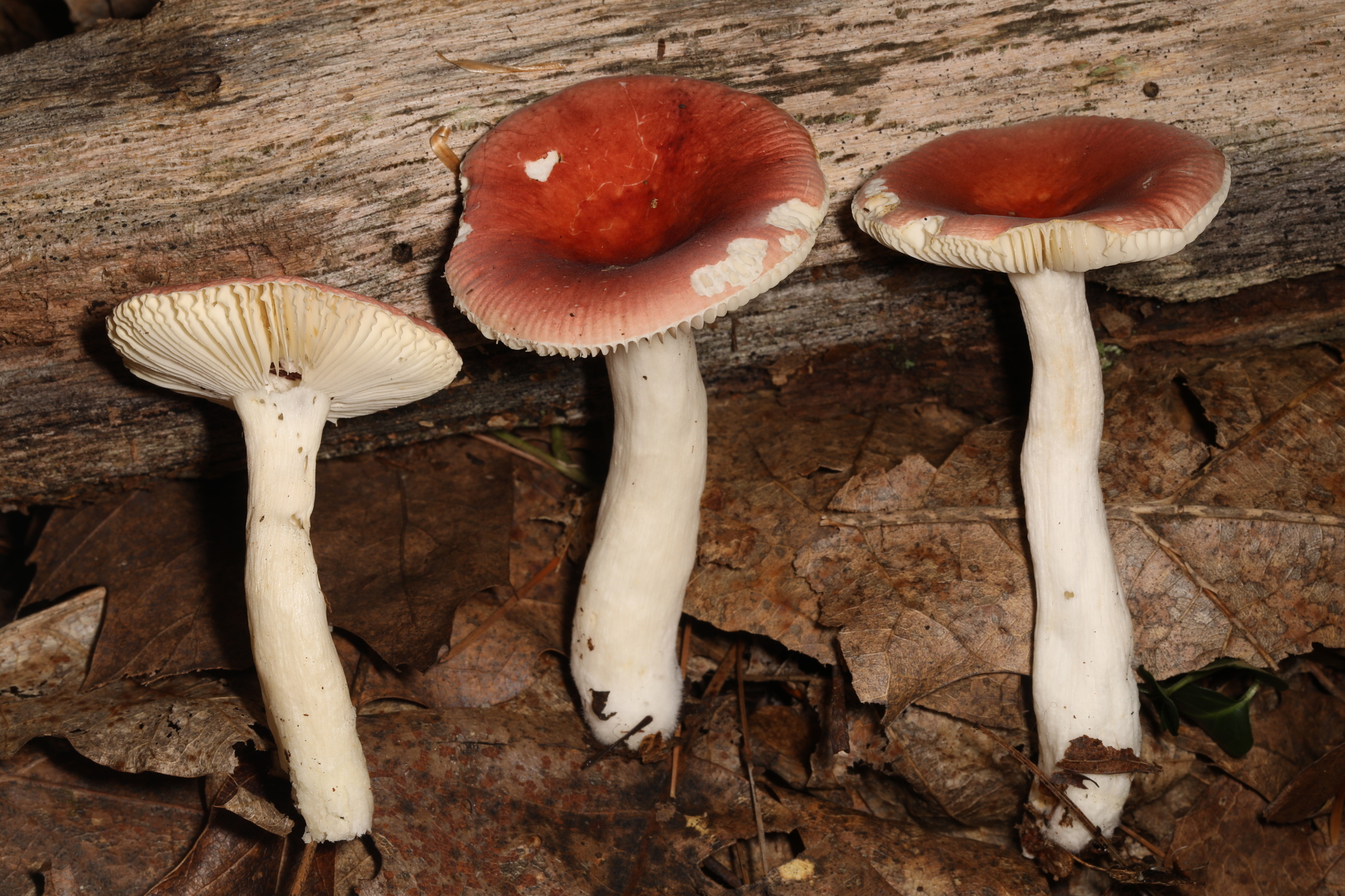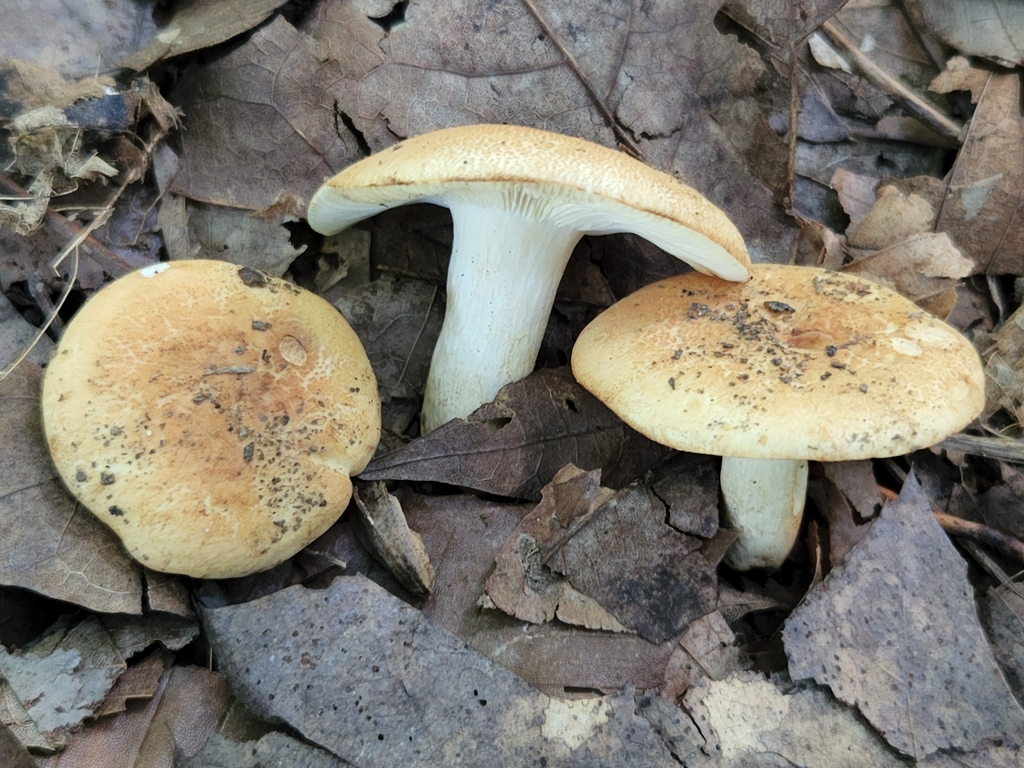
Russula amerorecondita photo © John Plischke
Ah, Russula. Everyone's favorite difficult-to-id, variable, brittle, and sometimes spicy genus of mycorrhizal fungi. Thanks to a combination of factors, these guys can be nearly impossible to get to a known species in the eastern US, even with sequences. Bart Buyck, a leading French Russula expert, put out a paper in 2007 titled 'A new initiative toward the study of Russula in the eastern United States' that brings light to some of the issues. Despite being over a decade old, it offers some good insight into why the understanding of the genus in our region became so convoluted.
There are a plethora of temp codes here; hopefully sequenced types will help demystify some of these shrooms.
Russula amerorecondita - Described in 2019. it is a brownish-yellowish (deer colored might be a good descriptor here?) mushroom. Some of the sequenced specimans that we have show a slight flush of color on the stipe, but it is faint.

Russula amerorecondita photo © John Plischke
Russula betularum - This species is described from Europe, but our sequences do match European sequences - its reasonable to conclude that they're the same species. Spicy in flavor, they have a cap that ranges in color from white or pale buff, pale pink, to deep pink, with a fully peeling cap cuticle and a stem that tends to be longer than the width of the cap. Presumably birch associated, but some reports show them around some conifer species (pine or spruce)

Russula betularum photos © Heather Clark
Russula cremeirosea - A small, delicate looking russula. Red to vinaceous cap that fades from the margin inward in maturity; partially peeling cap, mild taste, no odor. Cream colored gills have small amount of forking near stipe.

Russula cremeirosea photos © Jessica Williams
Russula "compacta-IN02" - This is a relatively large, fleshy, but squatty, russula. The coloration on the cap ranges from pale buff to white, is dry to the touch, and seems to be prone to pitting. They bruise a rusty color when scratched or bruise, and may have an intense odor reminiscent of fish gone bad or rancid meat. Popping one of these in the dehydrator truly leads to a bad time

Russula "compacta-IN02" photos© Stephen Russell
Russula katarinae - This is a small Russula, with a cap diameter generally less than 6cm. The cap coloration can range from orange, to orange-yellow or pale yellow, with a cap cuticle that peels to about 3/4 of the cap radius. The stipe is white and may be wider at the base than the top and stains brownish when bruised or cut. Gills are densely packed with some forking near the stipe, with an adnate to adnexed attachment. Mild tasting, with a fishy odor at maturity and a cream to ochre spore print.


Russula katarinae photos © Kyle Canaan
Russula "mariae-IN01" - Russula mariae sensu stricto was described from New York; there is a possibility this is the actual thing but there is a fairly wide range of sequences in the R. mariae group, so until the holotype is sequenced, this one will probably remain at temp code level. These russula tend to have pink-flushed stipes with a dark purple cap, though the cap color can be mottled and have yellow, white, or olive tones and well. The cap also tends to have a whiteish bloom on the surface when they are young. Gills are occasionally forking and lacking in lamellulae

Russula "mariae-IN01" photos © iNaturalist user Huafang
Russula parvovirescens - Formerly known under the temp code Russula "IN-30", this species was determined after Professor Buyck was kind enough to provide us with the sequence to his holotype. The species is a smaller species, with a cap diameter usually less than 7cm, a cap colored blue-green to gray-green, with scaley patches on the cap surface that may discolor pale to dark brown. The spore print should be cream colored and mature specimans will have a distinctly striate margin.



Russula parvovirescens photos © Jessica Williams
Russula "sp-FL08" - Currently known from one genbank accession from Florida and two observations in Ohio, we need more collections of this to get a good idea of what sort of variation it can have. Caps of collected specimans range from red to orange fading to yellow, and have cream gills lacking in lamellulae

Russula "sp-FL08" photos © Penny Hamilton Cooper
Russula "sp-IN2" - It's one of many red russula species, and there's only so much I can say about macro features for these. That said, they do seem prone to being lankier than most russula, with a stipe that is as tall, or taller, than the width of the cap. They also seem prone to fading - there are multiple specimans that have faded to white around the cap margin, only retaining red in the center of the cap.


Russula "sp-IN2" photos © John Plischke
Russula "sp-IN6" - Specimans under this code exhibit a fairly consistent buff or tawny cap & stem coloration; the cap surface seems to develop scattered cracks in age, and the stem color fades in older specimans, with the colored surface separating into small patches of color. The gills have some forking near the stipe, and lamellulae are present

Russula "sp-IN6" photos © John Plischke
Russula "sp-IN7" - Another red one! Gills not very crowded. Seems prone to getting spotty orange fading on the cap surface.

Russula "sp-IN7" photo © Jessica Williams
Russula "sp-IN61" - A bit distinctive. Color wise it's a muted brownish-greenish mushroom with a tinge of purple and a peachy fade at the cap center. Fresh specimans have a white cast that almost looks like the farina on a succulent plant. Possibly associated with Prunus sp.



Russula "sp-IN61" photo © John Plischke, Jessica Williams
Russula "sp-IN74" - A surprisingly distinct one. Most sequenced specimans have a pale mauve cap that fades to a peachy center, though there are a few that edge more greenish. Mild taste. It seems to be quite fragile, and a slug favorite; most of the sequenced specimans are in rough shape.


Russula "sp-OH04" - Known from only one speciman. Dry red cap, fading towards the margin. White gills, close but not crowded, no lamellulae


Russula "sp-OH04" photos © Penny Hamilton Cooper
Russula "sp-OH05" - As of this writing, only known from a single specimen, but it seems to be closely related to the west coast R. pseudotsugarum. Conifer-associated, red-capped with a striate, paler margin. White stipe. Brittle gills are spaced close but not crowded, lacking in lamellulae and forks


Russula "sp-OH05" photos © Heather Clark